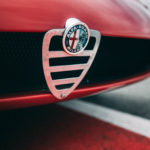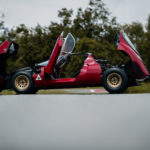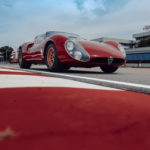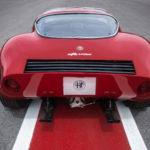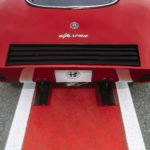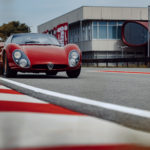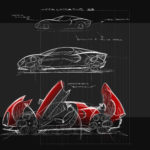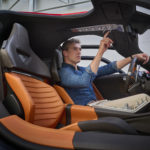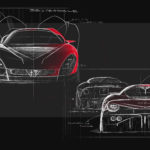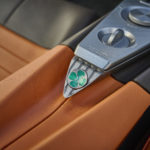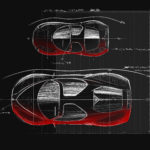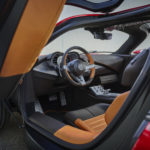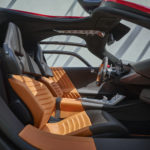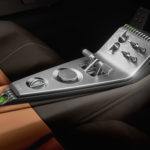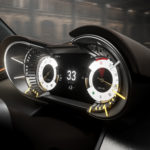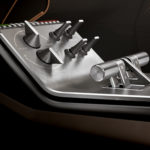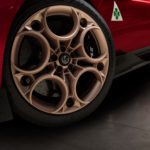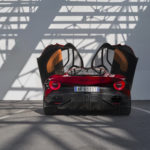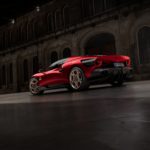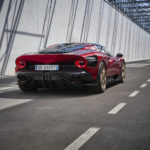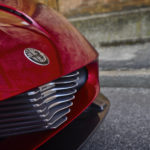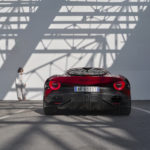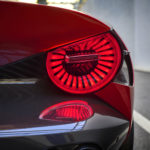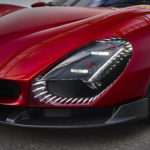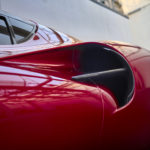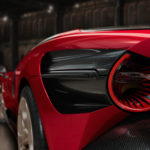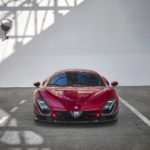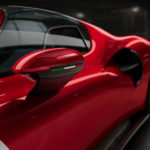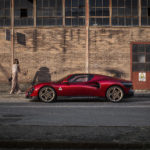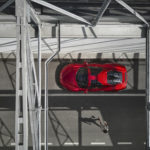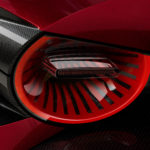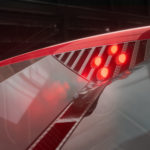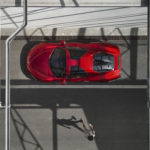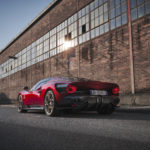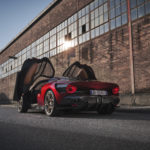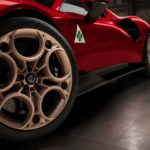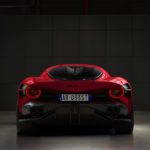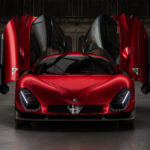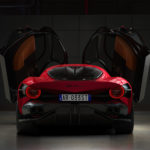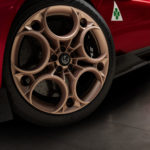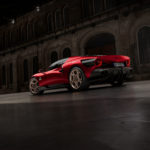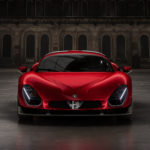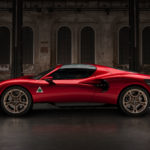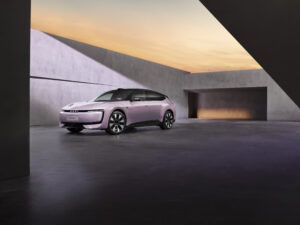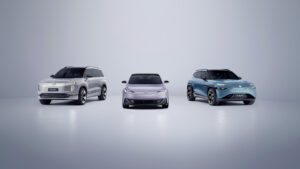Alfa Romeo 33 Stradale “fuoriserie” Design Background
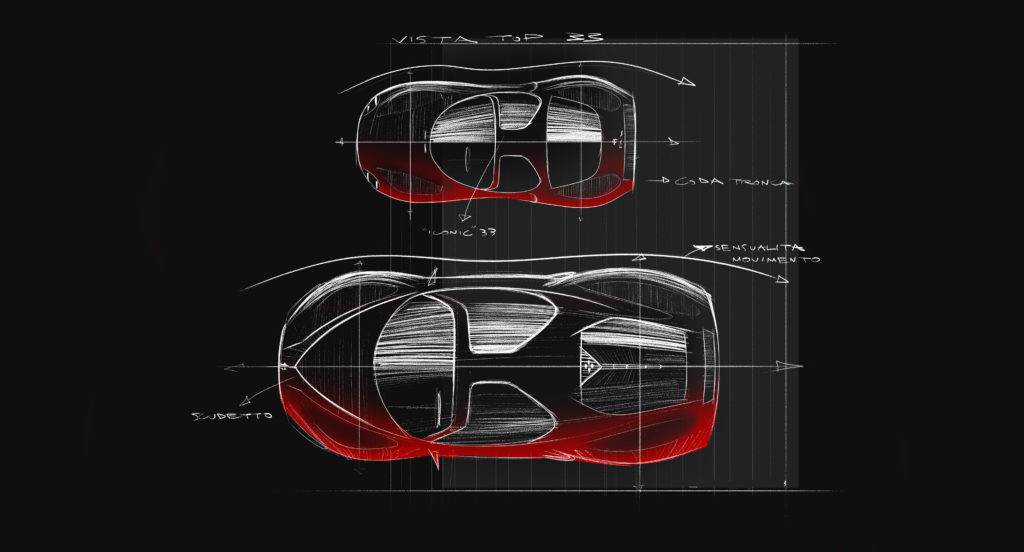
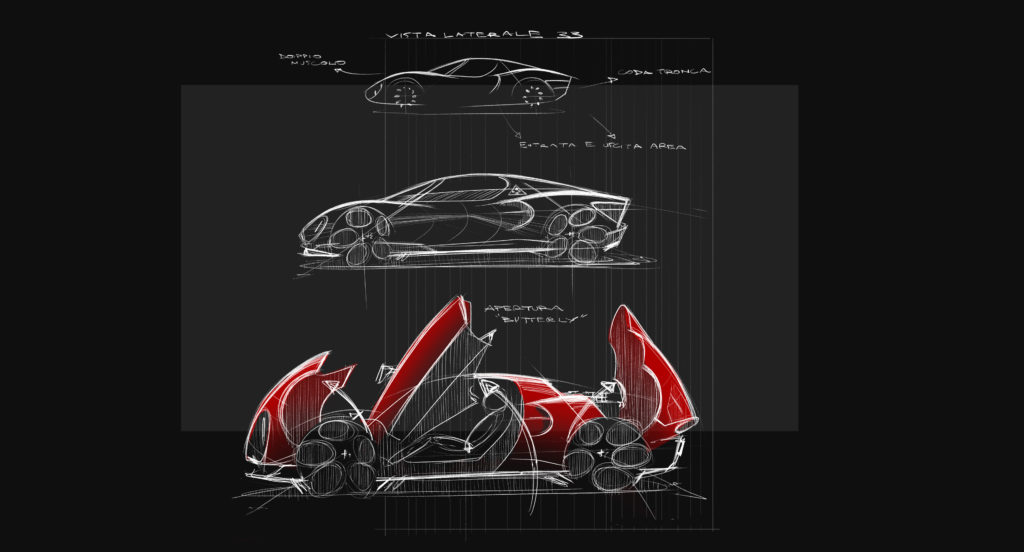
Alfa Romeo is delighted to announce the rebirth of the “fuoriserie” (custom-built)33 Stradale, a veritable manifesto of the Italian brand’s capabilities – now and in the future – in terms of style and driving experience. Made in only 33 exclusive units, according to a unique artisan process, the new two-seat coupé combines the brand’s heritage and future as the symbol of noble Italian sportsmanship.
To make a dream come true, the essential ingredients are a good dose of courage and a pinch of healthy madness. This was the same recipe used for the car considered by many to be among the most beautiful ever: the 33 Stradale, launched in 1967. Today, with the same boldness and vision, the Alfa Romeo team has designed and developed the new 33 Stradale, an authentic work of art in motion, the perfect combination of beauty and technology. Its goal is to provide the most exciting driving experience and the immortal charm of an icon to a very small circle of enthusiasts, who have believed in the project from the outset. The new 33 Stradale was created at the newly founded Alfa Romeo Bottega, where, following in the footsteps of Renaissance artisan boutiques and the 1960s workshops of renowned Italian coachbuilders, the brand’s designers, engineers and historians listened to potential buyers, before producing the car to their specification.
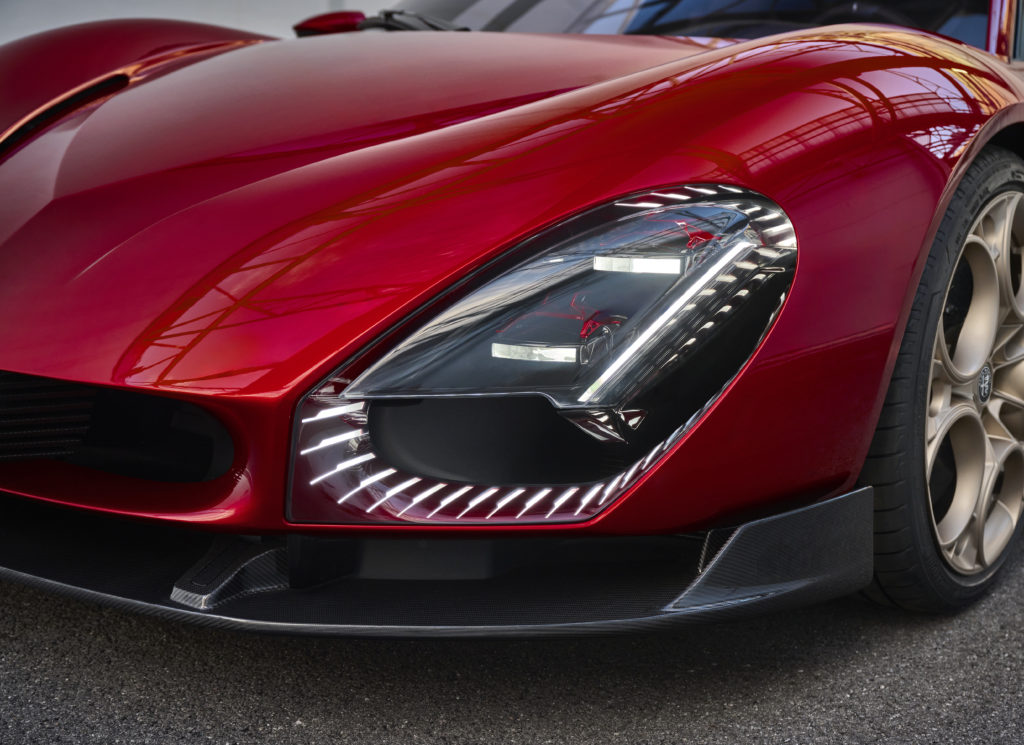
In the words of Jean-Philippe Imparato, CEO of the Alfa Romeo brand:
“With the new 33 Stradale, we wanted to create something that lived up to our past, to serve the brand and to make the Alfisti fandom proud. Such a result could only have been achieved thanks to the expertise, hard work and passion of our team, with the support of management who have the clear ambition to contribute to writing chapters in the brand’s future, in full respect of its unique history. This is the brand’s first “fuoriserie” (custom-built) car since 1969, and I promise it won’t be the last.”
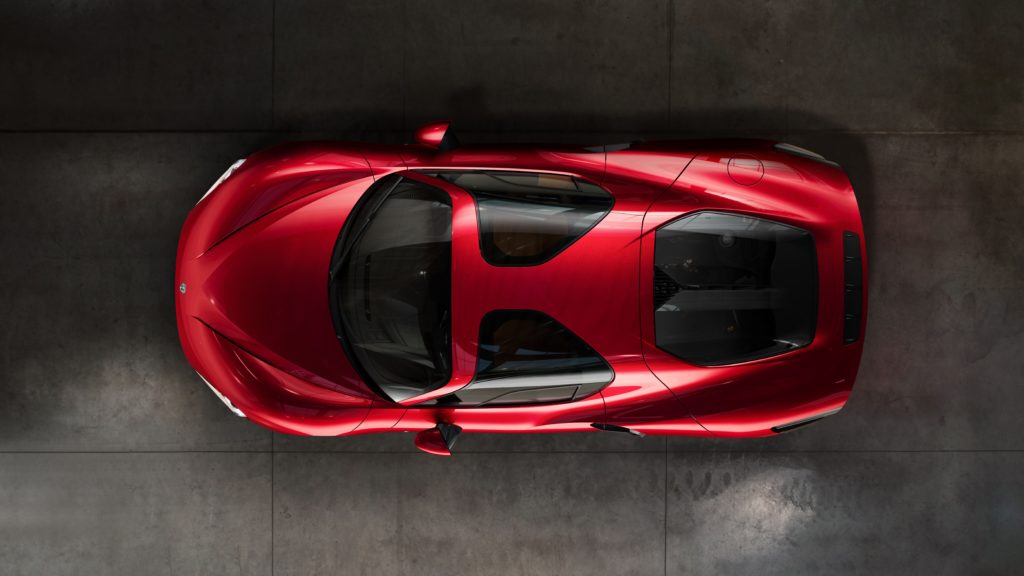
The epitome of necessary beauty
Produced by the Alfa Romeo Centro Stile, the new 33 Stradale is inspired by the historic 1967 model enriching its sculptural beauty with elements from the new Alfa Romeo design language. The exterior features a perfect balance of proportions, volumes and processing of the surfaces, epitomising the necessary beauty of Alfa Romeo, the creative principle inherent in the brand’s DNA that sees aesthetics and technique profoundly intertwine. The front has a powerful and muscular volume, where the standout features are the iconic Scudetto shield and the lights with their complex form and elliptical base. The profile is dynamic and slender, with butterfly doors and two large air inlets on the side. The body is projected forward, with surfaces modelled according to the typical formal Alfa Romeo expression. The corner opening doors and the large wraparound sunroof allow the driver to enjoy a unique view, reminiscent of and airplane cockpit. The brutal rear is balanced by the sinuous front and the maximum height is not at the level of the windscreen, as on any other sports car, but in the middle of the roof. The rear area expresses the strength of the car courtesy of the truncated tail, V-shaped graphic and round rear light clusters. The aerodynamic efficiency is confirmed by a Cx (aerodynamic drag coefficient) of 0.375 at zero Cz (downforce) – for precise handling without the aid of active systems.
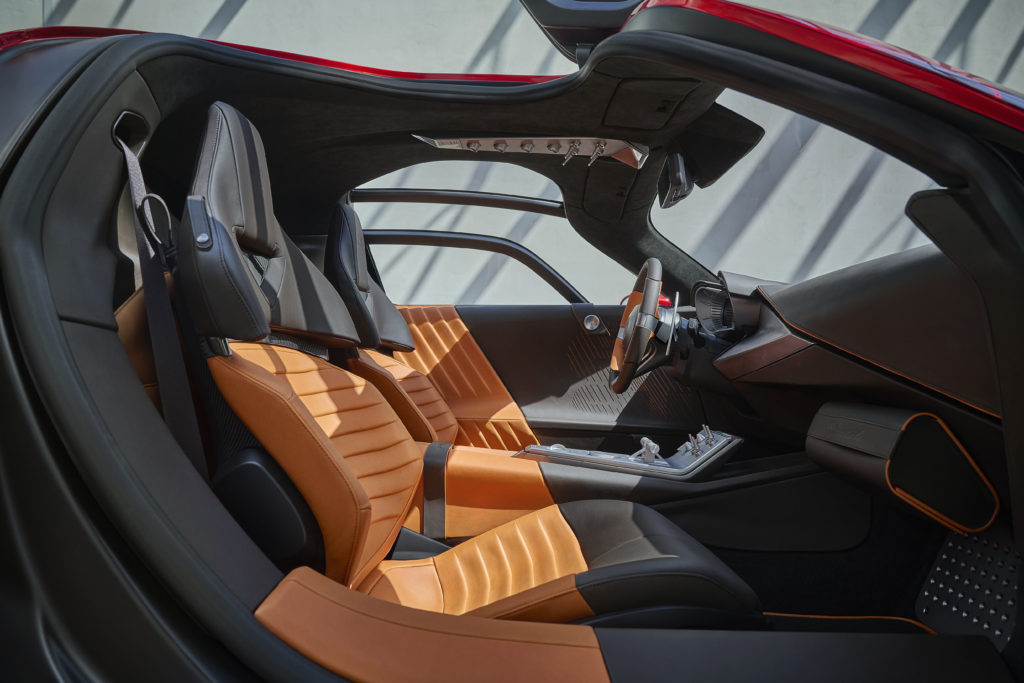
The interiors are also distinguished by this minimalist approach to design and materials, designed to provide the most engaging driving experience. The cockpit was designed to minimise components that could distract the driver, as seen in the limited number of controls on the centre console all with a practical use when driving. Directly ahead of the driver is a display, the 3D telescopic design engages the driver in a first-of-its-kind interaction. The steering wheel, devoid of all its usual buttons, enhances the experience and put the focus on the pure pleasure of driving. As in an airplane cockpit, the controls are located at different levels, in the low centre console and on a higher plane, installed in the central lining on the inside of the roof. The interior is available in two trims: Tributo and Alfa Corse. The aviation-inspired dashboard and central tunnel employ materials such as aluminium, carbon fibre, leather and Alcantara. The wraparound seats reinterpret those of its forerunner, ensuring comfort and ergonomics. Every detail is designed to create an exclusive and engaging environment, maintaining the aesthetic and technical heritage of the 1967 33 Stradale.
A unique driving experience
The new Alfa Romeo special edition can be fitted with a V6 twin-turbo engine delivering over 620 hp or can come in a BEV configuration with over 750 hp. Performance is outstanding in both versions. The top speed is 207mph (333km/h), and it accelerates from zero to 62mph in under three seconds. The double-arm suspension with active shock absorbers and the front axle lift ensures exceptional handling and comfort. The Alfa Romeo Brake-By-Wire braking system and Brembo carbon-ceramic brakes offer high-level performance.
The aluminium H-frame and carbon fibre monocoque guarantee rigidity and lightness. To ensure high levels of rigidity and safety, the roof structure has been engineered in carbon fibre and aluminium, with hinged butterfly doors. The window frames are also made of carbon fibre, with the rear window in polycarbonate.
The car’s tuning will be supported by F1 driver Valtteri Bottas, on the legendary Balocco track, bringing F1 experience into everyday driving and ensuring the unmistakable handling of an Alfa Romeo.
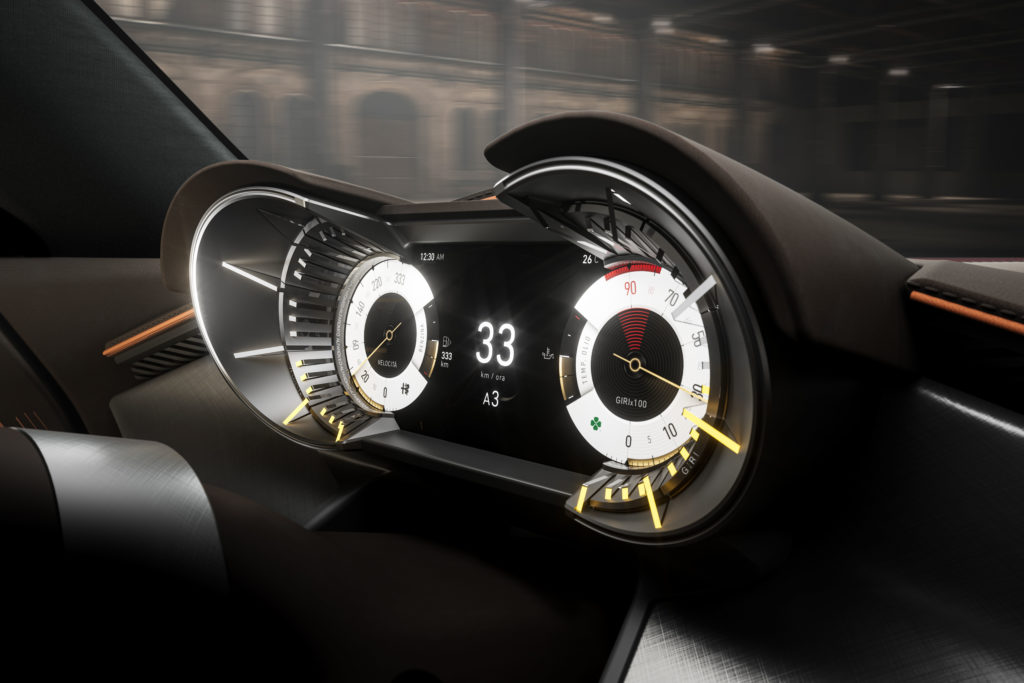
The Bottega
The 33 project has brought about the Alfa Romeo Bottega, a team of professionals who have worked closely with customers to design 33 unique and exclusive specimens. The Bottega is inspired by Renaissance workshops and by 1960s coachbuilders, all of whom created works of art of pure beauty, according to their clients’ requirements. Likewise, customers have been involved in the creative process since the beginning of the project. The first meetings with some of them took place at the 2022 Monza Grand Prix, where they had the opportunity to express their desires for the car. Within a few weeks, all 33 units had been sold. The Bottega is headquartered in the Sala del Consiglio of the Museum in Arese, where the design of the 33 Stradale was approved in 1967. However, the 33 Committee approves customer requests, ensuring that the car’s history and iconicity are respected. This committee is chaired by the CEO of Alfa Romeo, and comprised of the heads of the brand’s various departments.
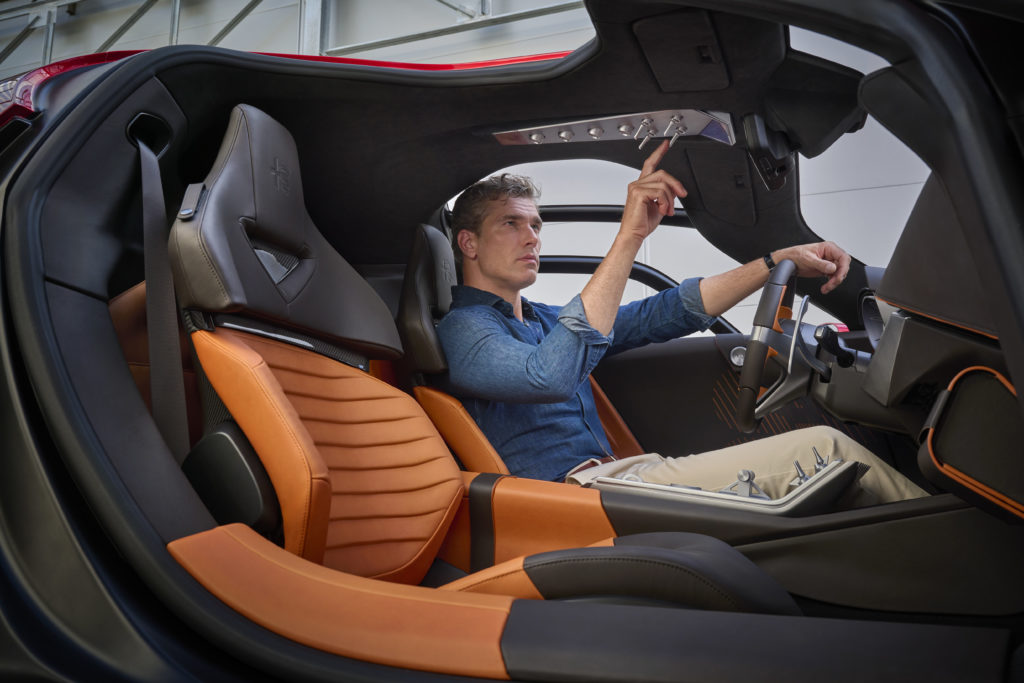
Craftsmanship and innovation for an unprecedented level of customisation
The new custom-built car will be produced in just 33 units, via a dedicated program that has enabled customers to develop functional stylistic elements together with the Alfa Romeo development team: air intakes, wheels, and even the distinctive front shield. Therefore, no two cars will be identical, making them masterpieces on four wheels, with the ambition of becoming part of Alfa Romeo history. The same uniqueness also shows up in an exclusive registration procedure that enables customers to personally “sign” the chassis number. The specific VIN includes eight digits chosen by the customer and is also marked on the central tunnel. With a consolidated experience in the field of the most exclusive tailor-made automobiles, Alfa Romeo will be employing the craftsmanship of the Carrozzeria Touring Superleggera to construct the cars with their exceptional quality standards and obsessive attention to detail.
The roots of the legend
The 1967 33 Stradale was derived directly from the Tipo 33, the monarch of world motorsport in that era. Project 33 marked the return of Alfa Romeo to racing, led by the brand’s then President Giuseppe Eugenio Luraghi and by Carlo Chiti of Autodelta, the newly formed racing department. The time trial at Fléron, near Liège, was chosen for its debut. The driver was the chief tester at Autodelta, Teodoro Zeccoli. On 12th March, 1967, the 33 entered the world of competition. It scored an immediate victory, the first in a long line of successes on the most prestigious circuits that would take it to the top of the world, with victories in the Championship for Makes in 1975 and ’77. On the wave of sporting enthusiasm, Alfa Romeo decided to produce the 33 in a very limited edition for private individuals, as a “fuoriserie” (custom-built) car that combined the performance of the Tipo 33 racing car with comfort and drivability suitable for everyday use.
The design was entrusted to Franco Scaglione, who put all his technical expertise and creative daring into the design of the 33 Stradale, resulting in a masterpiece where innovation in style blends with the quest for aerodynamics and functionality. The design of the 1967 33 Stradale, the quintessence of beauty in a car, is almost impossible to describe: its expressions were the balance of its forms, the purity of its lines, the elegance of its every detail. Between 1967 and 1969, only 18 specimens were produced, one of which is kept today at the Museum in Arese, making it an extremely rare piece much coveted by collectors. Six of these chassis were used to make prototypes, which anticipated two decades of automotive design: the Carabo (1968), the P33 Roadster GS (1968), the 33/2 Coupé Speciale (1969), the Cuneo (1971), the Iguana (1969), and the Navajo (1976). In short, the 33 Stradale is a legendary model that has marked not only the history of Alfa Romeo, but also that of Italian design.

DESIGN – THE MANIFESTO OF NECESSARY BEAUTY
- The sensual and attractive line makes this custom-built car unique, combining beauty and performance
- The exterior features a perfect balance between proportions, volumes and processing of the surfaces, and becomes the epitome of necessary beauty
- The front features the sinuous roundness typical of Alfa Romeo, with references to the unmistakable V on the bonnet and the iconic Scudetto shield
- The profile is sleek and dynamic, with side air intakes and butterfly doors that enhance accessibility and ergonomics, and offer a unique panoramic view for the driver
- The rear expresses the brutal essence of the 33 Stradale, with a V-shaped graphic and round rear light clusters
- The aerodynamic efficiency is confirmed by an excellent Cx of 0.375, achieved without the assistance of active aerodynamic devices
- The interiors are offered in two trims, Tributo and Alfa Corse, characterised by high-quality materials and design inspired by its 1967 forerunner
- The sports steering wheel and the telescopic instrumentation emphasise the concept of driver orientation, with a precise and direct driving feeling
- The dashboard and central tunnel feature mechanical details inspired by aviation, while the enveloping seats and door panels contribute to creating an exclusive and comfortable environment
Alejandro Mesonero-Romanos, Head of Alfa Romeo Design: “The 33 Stradale project has come about as a result of the passion and dedication of a small team of designers and engineers at the Alfa Romeo Centro Stile. The design is inspired by Franco Scaglione’s masterpiece of 1967, with a bold look to the lines of future Alfa Romeo models. The result is made possible by the expertise and the best tradition of Italian design. A true manifesto of essential beauty: a limited number of lines, sensual and at the same time powerful capable of arousing desire and strong emotions.”
The sensual and attractive line – the work of the Alfa Romeo Centro Stile – gives this unique car a combination of beauty and performance. With the respect garnered by authentic icon, but with just as much personality and audacity, the Alfa Romeo Centro Stile began to study its proportions and the harmony of its lines, with enhancing its sculptural beauty with design elements from the new Alfa Romeo design language. The car’s proportions are fully in line with the original: the wheelbase relates to the length; the diameter of the wheels relates to the height. In addition, certain design details have changed, but the inspiration remains the same: the brutal rear is balanced by the sinuous front and the maximum height is not at the level of the windscreen, as on any other sports car, but in the middle of the roof.
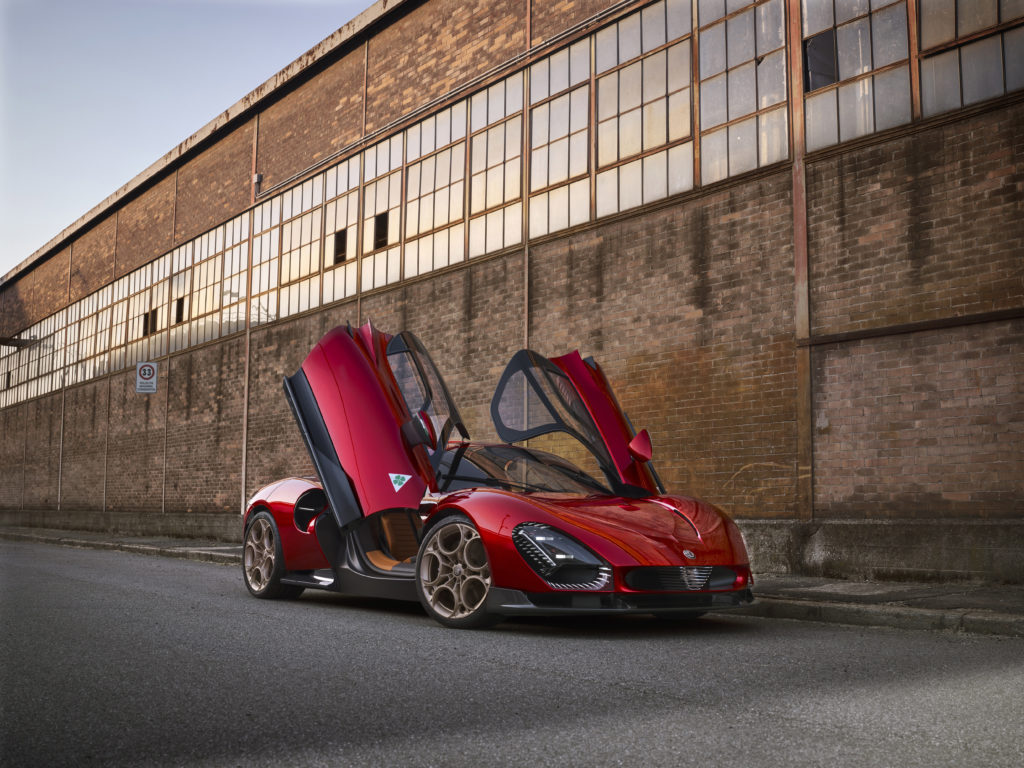
EXTERIOR
At first glance it captivates the viewer with the perfect balance between proportions, volumes and processing of the surfaces of the new 33 Stradale. An exciting combination that stands as the epitome of necessary beauty, the creative principle inherent in the brand’s DNA that sees aesthetics and technique profoundly intertwined.
Front: the 33 Stradale has a powerful and muscular volume, featuring the sinuous roundness typical of Alfa Romeo, epitomised by the 1967 33 Stradale. Certain stylistic features also refer to the unmistakable V on the cofango – this term identifies the single component that integrates the bonnet and wing, to recall the air outlet of the 33/2. The front of the car also features the characteristic Alfa Romeo Scudetto shield in carbon fibre – with the customer able to choose the classic logo or a 3D version – as a natural point of convergence of the two ribs that run along the front. The features and DNA of the historic 33 are preserved in the look of the extremely evocative and clearly recognisable car. This is the result of the lights with their complex shape on an elliptical base, within which reside refined objects of design and technology, to breathe life into functions and performance with a modern flair. The design of the front is completed by the aerodynamic carbon fibre appendages located in the lower part.
Sides: strongly slender and dynamic, the sides ideally transfer all the power and energy expressed by the car’s powerful musculature to the rear axle. Two large side air intakes, necessary for the intercooler, graphically and volumetrically define the origin and development of the muscles of the rear. The body is projected forward, with surfaces modelled according to the criteria typical of the formal Alfa Romeo expression. The cylindrical sections and the brand’s typical processes convey that characteristic sensuality that unites the historic and current models.
A feature that has been deliberately replicated is the opening of the front and rear cofango, offering both a theatrical opening and quick access to the mechanical parts in full racing style. The butterfly doors deserve a separate section. As well as paying homage to the historic 33 Stradale where they were first seen, their kinetics guarantee excellent accessibility and ergonomics. In addition, courtesy of the corner opening of the doors and the large wraparound sunroof, the driver can enjoy a unique view of the road, the scenery and the sky, so much so their experience becomes very similar to in the cockpit of an airplane. The overall image offered by the opening of the cofango and doors enhances the car’s theatricality.
Rear: This part of the car embodies the “brutal” essence of the Stradale. The central V-shape of the truncated tail enhances perception of the body colour, keeping the technical part in carbon fibre at the bottom in view. The thoroughly evolved taillights stand as a powerful reference to their round counterparts in the car’s predecessor. The side direction indicators are divided into two parts, one integrated in the centre of the rear light cluster and another that emerges from the side of the wing, breathing life into a reinterpretation of the side air outlets behind the rear wheel.
Aerodynamics: From the outset, the development of the exterior of the 33 Stradale was characterised by the need to enhance the car’s style and technical specifications, from both a dynamic and aerodynamic point of view. Therefore, all the style solutions adopted have been optimised according to the ultimate goal: performance. The headlights in the lower part integrate an air intake to direct the air flow and to feed the radiator; in the sides they give rise to an aerodynamic slot which improves the car’s Cx. Similarly, the support arm of the rear-view mirrors has the secondary role of a spoiler to direct the air flow towards the side intakes, to maximise their performance. These solutions, combined with sculptural forms, enable the 33 Stradale to achieve the highest levels of aerodynamic efficiency. Air envelops the car and follows its natural path, unhindered by edges and irregularities. This results in a ground effect, which contributes to increasing stability at high speeds. An initial meticulous CFD analysis, followed by testing in a wind tunnel, made it possible to achieve an excellent Cx (aerodynamic drag coefficient) of 0.375, without assistance from active aerodynamic systems.
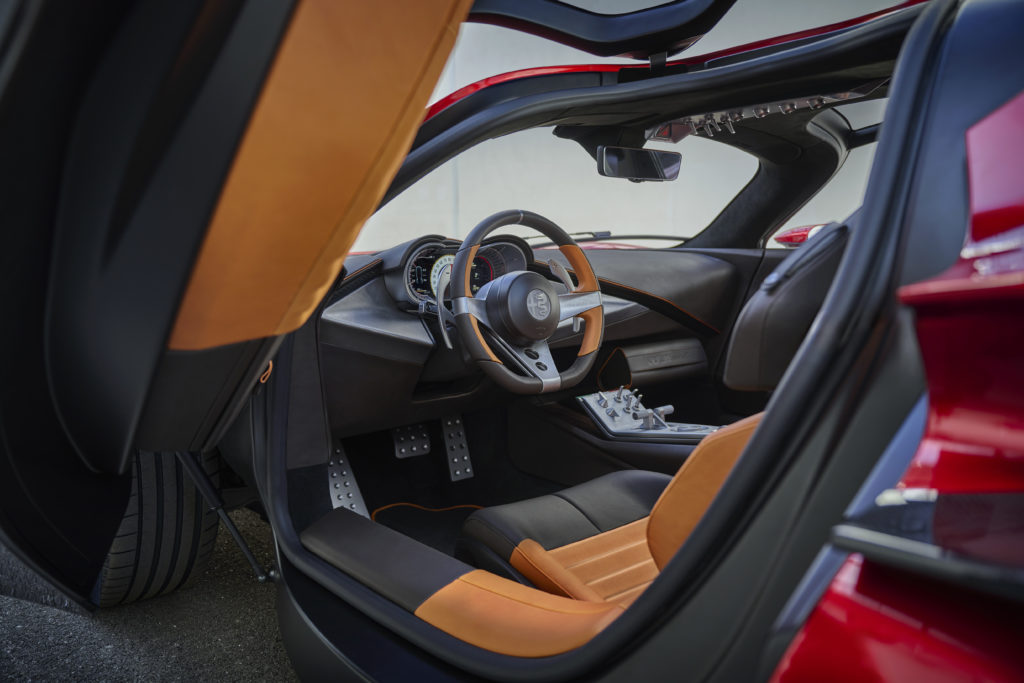
INTERIOR
The interior – available in the Tributo configuration, a homage to the historic car, and in Alfa Corse, the sportiest expression – is also distinguished by a minimalist approach to design and materials to offer the most engaging driving experience. Inside the 33, as in the historic car, the driver and passengers can experience the precise intent to offer an approach to driving totally purified of all the interactions required in a conventional car. A limited number of controls with a practical usage when driving can be found on the centre console. Directly ahead of the driver is a display, the 3D telescopic design engages the driver in a first-of-its-kind interaction. Just like in every Alfa Romeo, the steering wheel is the primary means of communication with the car; devoid of all the buttons it usually comes with, it gives you an experience of pure driving pleasure, courtesy of the prestigious aluminium shift paddles. As in an airplane cockpit, the controls are located at different levels, in the low centre console and on a higher plane in the central lining on the inside of the roof.
Sports steering wheel and telescopic cluster:The 33 Stradale enhances the concept of driver orientation, made possible by two essential components for any Alfa Romeo: the steering wheel and the driver’s instrument panel. The former is compact and sporty in shape, ensuring a precise and direct steering feeling; it is also embellished by the clean lines given the lack of controls on the steering wheel, and by the three spokes in aluminium on the Tributo and carbon fibre on the Alfa Corse. The second hallmark is the telescopic instrument panel, with a clear Alfa Romeo stylistic matrix, bringing together all the information required when driving. Depending on which of the Road and Track drive modes is selected, the instrument cluster has easy-to-read graphics, meaning the driver can keep everything under control without distractions from commands that would be superfluous on this type of car.
Dashboard and central tunnel: inspired by the world of aviation, a field intrinsically linked to the history of the brand, the central tunnel features “mechanical” switches for the few functions where there is absolutely no room for doubts or errors. Therefore, even starting the new 33 Stradale is an immersive experience to be enjoyed to the fullest. The simple and function-based dashboard features the combination of the cold solidity of aluminium and/or carbon fibre, and the warmth and softness of leather and/or Alcantara. The traditional air vents are hidden in the volume of the dashboard, making it a clean and sporty component.In addition, between the dashboard and the central tunnel is a large retractable display, to manage all the settings of the Alfa Romeo special edition. Each and every model is equipped with a refined and powerful seven-speaker Premium audio system, for total immersion in sound.
Seats and door panels: comfortable and enveloping, the seats are the contemporary reinterpretation of the originals, as seen in the colours and the famous side ribbing; they also have six-way electric controls and four lumbar positions. Finally, the same materials and colours as the seats are used in the upholstery of the door panels, the dashboard, the cockpit and the central tunnel, creating an exclusive environment.
TECHNICAL – AN UNFORGETTABLE DRIVING EXPERIENCE
- The new 33 Stradale boasts the best of Made at Alfa Romeo engineering, including double-arm suspension with active shock absorbers and the evolution of both the V6 engine that already features in the Italian brand’s highest-performance cars
- Available with a 3.0-litre V6 twin-turbo engine with over 620 hp and an eight-speed DCT gearbox, rear-wheel drive and electronic limited-slip differential, or in BEV configuration delivering over 750 hp, with an estimated range of 450 km (WLTP)
- An indicated top speed of 333 km/h and acceleration from zero to 62mph in under three seconds, with braking from 62mph to zero in under 33m
- H-frame aluminium chassis and carbon fibre monocoque: the light and rigid structure optimises the car’s agility and drivability
- Double-arm suspension with active shock absorbers, for exceptional handling and unparalleled comfort, and front axle lift to deal with obstacles on the road
- The tuning will benefit from the collaboration of F1 driver Valtteri Bottas, to offer a driving experience as a track car while remaining suitable for everyday use on the road
The Alfa Romeo team dedicated to the new 33 Stradale was assigned an ambitious goal: to offer a driving experience as a track car but in everyday use on the road, where the driver could experience excitement even as a non-professional. Indeed, the new 33 Stradale is type-approved to be driven on the road, but boasts superior levels of performance, drivability and comfort. To ensure this, all 33 models will be developed, tested and certified by a team of dedicated engineers, working with F1 driver Valtteri Bottas. The Finnish champion will support the car’s tuning at the Balocco Proving Ground in Vercelli province, bringing F1 experience into everyday driving and ensuring the unmistakable handling of an Alfa Romeo.
ICE and BEV configurations: the 33 Stradale can be fitted with a 3.0-litre V6 twin-turbo engine with over 620 hp and an eight-speed DCT gearbox, rear-wheel drive and electronic limited-slip differential, or in BEV configuration delivering over 750 hp, with an estimated range of 280miles (450 km) WLTP. In detail, the internal combustion engine is the evolution of the V6 already fitted to the Italian brand’s highest-performance cars and it is mounted longitudinally in the centre and enables the car to reach a top speed of 333 km/h, accelerating from zero to 62mph in under three seconds. Not to mention the fact that the driver can select the drive mode using the switches on the central tunnel: Road and Track. The former is Strada (‘Road’) mode, engaged when the car is started, which ensures comfort and driving pleasure: smooth power delivery, soft suspension, fluid transmission and active exhaust valves open only above 5,000 rpm. In “Pista” (‘Track’) mode, the customer chooses an adrenaline-fueled drive: the power is at its peak, the pedals are even more responsive and the suspension is rigid. When powered by the V6 twin-turbo engine, Pista offers rapid gearshift and active exhaust valves that are always open and in this drive mode the driver can choose to deactivate all the traction control (ESC OFF).
H-frame aluminium chassis and carbon fibre monocoque: dynamic development and tuning are carried out by exploiting the flexibility offered by the rigid and light structure of the 33 Stradale, for which extensive use has been made of lightweight materials, the result of a production that combines high-tech processes with the most rigorous craftsmanship. The H-frame is made of aluminium to obtain maximum torsional rigidity and to guarantee a precise and safe ride, while the monocoque is made of carbon fibre. The choice was motivated by the need to reduce weight as much as possible but also to optimise the car’s centre of gravity to the advantage of agility and drivability on the most demanding routes. To ensure high qualities of rigidity and safety, a roof structure has been engineered in carbon fibre and aluminium, with specially developed hinges for the butterfly doors. The window frames are also made of carbon fibre, with the rear window in polycarbonate.
Suspension: The new 33 Stradale adopts a dual-arm suspension scheme with active shock absorbers and semi-virtual steering on both the front and rear axles. This 100% Alfa Romeo technology provides optimum control of the steering wheel and the highest degree of steering precision. It also provides great lateral acceleration, ensuring the best handling in all driving conditions. In addition, the system can filter the roughness of the road surface, to make the driver more comfortable.
Front axle lift: the system enables the lifting of the front when passing obstacles, such as bumps, rails or when entering parking lots or garages, to avoid damage to the bodywork. The driver can activate this function via the Assetto (‘setup’) control on the central console, when driving at under 25mph (40 km/h). The hydraulic system raises the front axle by about 50mm to overcome the obstacle, then returns it to the standard height by manually deactivating the system or when exceeding the speed limit set.
Performance controls: to fully enjoy the exciting driving experience on board the 33 Stradale, certain parameters can be set. For example, when the car is in Pista mode, the driver can launch the Fast Start procedure via the Quadrifoglio button on the central tunnel. The system acts on the gearbox, traction control and power to maximise acceleration by avoiding wheel slippage. Alternatively, using the suspension selector, the driver can change the suspension settings in both drive modes, switching from soft to medium when in Strada mode, or from rigid to medium if the Pista function is activated.
Braking system: the new 33 Stradale is equipped with the integrated Alfa Romeo Brake-By-Wire braking system, offering both control of braking pressure and ensuring stability in the feeling of the pedal, which also depends on which drive mode is selected. Produced by Brembo for Alfa Romeo, carbon-ceramic brakes guarantee high performance and ensure reactive braking with a reduced fading effect at high temperatures. In the front and rear, the discs are ventilated and perforated with a six-piston monobloc caliper in aluminium in the front, with a four-piston system in the rear. As well as the classic Rosso, Nero and Giallo colours, the calipers can be customised in other colour solutions on request.
THE “BOTTEGA” – ARTISANS AT CUSTOMERS’ SERVICE
- Inspired by Renaissance boutiques and by 1960s coachbuilders, a team of Alfa Romeo professionals has worked with customers to design 33 unique and exclusive specimens
- All 33 models of the new Alfa Romeo special edition sold out within just a few weeks
- Chaired by the CEO of Alfa Romeo, the 33 Committee consists of the heads of various departments and approves customer requests, ensuring that the car’s history and iconicity are respected
Creating a unique and unrepeatable work of art, shaping matter and colours in a form of pure beauty. This principle is rooted in the Italian Renaissance, where master artisans breathed life into objects of great appeal and quality, according to their customers’ specifications. The same philosophy was in place at the workshops of the most famous Italian coachbuilders of the 1960s: at the request of car manufacturers or individual buyers, they produced some of the most beautiful icons in the automotive industry, all by hand. The same principle lives on today in the Bottega, a team of Alfa Romeo professionals who worked for a year in close contact with customers to arrive first at the definition of the concept of the new 33 Stradale, then at designing 33 unique and exclusive specimens.
The first meetings with potential buyers were held at the 2022 Monza Grand Prix, where collectors and fans of the brand could appreciate the first sketches of the car, created through the passion and pride of the Alfa Romeo Centro Stile. The idea of reviving the icon touched these fans so deeply that, within weeks, all 33 units had already been sold.
Alfa Romeo then decided to reopen the Sala del Consiglio of the Museum in Arese, where the design of the 33 Stradale was approved in 1967, as the Bottega’s headquarters. Customers were welcomed there to record their wishes for their cars, with full respect for the founder’s history and iconicity.
CRAFTSMANSHIP AND INNOVATION FOR AN UNPRECEDENTED LEVEL OF CUSTOMISATION
- Produced in only 33 specimens, each customised and unique based on numerous variations of exclusive body colours, prestigious coatings and innovative materials
- Alfa Romeo will be employing the Carrozzeria Touring Superleggera to build this limited edition, combining artisan processes, technological innovation and customer desires
- Customers can choose from four exclusive liveries, different carbon fibre finishes and various logos
- Two distinct styles for the interior: Tributo with leather and aluminium, and Alfa Corse with carbon fibre and Alcantara, both with different combinations of colours and finishes to exalt the car’s character
The 33 Stradale will be produced in just 33 units, customised by selecting from numerous variations of body colours, upholstery and fabrics; there will also be a program dedicated to customers with specific requests who want to customize their car further, to leave an indelible and personal signature in the history of Alfa Romeo. Therefore, no two cars in the world will be identical, making them “masterpieces on four wheels,” with the ambition of becoming part of Alfa Romeo history. Every single car is designed to be unique, so each one is registered according to an exclusive procedure and with a specific VIN.
The first three letters identify the Alfa Romeo “ZAR” brand, while the last five digits were chosen in conjunction with the 33 customers and define the vehicle as “33STR”. Finally, the last eight digits can be customized by the 33 owners and act as the customer’s “signature.”
This identification code will be engraved above the central tunnel, with a plate – inspired by its 1960s counterpart – placed in the rear compartment to certify the specificity of components such as the chassis, engine(s), gearbox/battery and monocoque.
With consolidated experience in the field of the most exclusive tailor-made automobiles, Alfa Romeo will be employing the Carrozzeria Touring Superleggera, one of the most famous companies in the world that has already left its mark on some of the most beautiful Alfa Romeos of all time. Therefore, the Biscione brand’s custom-built new model represents a new way of conceiving the production of limited editions by skillfully combining artisan processes, technological innovation and customer desires, a little like what happened in the early 20th century when Alfa Romeo modeled its creations with the collaboration of famous Italian coachbuilders. The customer will then be accompanied throughout the customisation process, translating his desires and dreams into something tangible and real. To support this journey through the car’s customisation, two interior styling proposals (Tributo and Alfa Corse) were developed as a basis for the configuration of the 33 Stradale. As a result of the flexibility of craftsmanship, personal requests are also possible, for example the use of a specific coating or body colour, which will be fulfilled subject to the approval of the 33 Committee.
Initially, customers can choose from three exclusive body colours that recall the history of the 33 Stradale: The classic pastel Rosso Alfa, a reinterpretation of royal blue, and the more sophisticated tinted clearcoat Rosso, known as Villa d’Este. The car can also be liveried in white and red as a tribute to the legendary Tipo 33 racing car. Customers also have the option to select and customize the visible carbon fibre finishes, choosing between different configurations of air intakes, to prefer the logo to be affixed to the side between Quadrifoglio and Autodelta, and to opt for the classic or 3D configuration of the front grille. The Alfa Romeo signature on the rear is also available in black, gold or silver. The same colours appear in the 20-inch Tributo alloy wheels, plus the refined two-tone option. Finally, the brake calipers are optionally available in black, red or yellow while the double tailpipe can be finished in brushed chrome or black.
Inside, the new 33 Stradale is available in two trims: Tributo and Alfa Corse. The former is marked out by leather and aluminium, and pays homage to the 1967 33 Stradale on show at the Museum in Arese. The standout feature here is the interior upholstery in two-tone biscuit leather and slate, used in the seats, dashboard, door panels and central tunnel. Customers can also opt for other two-tone solutions, such as red/black or blue/slate. Conversely, the Alfa Corse trim is a triumph of sportiness, with the combination of carbon fibre and Alcantara: the upholstery of the seats, dashboard, door panels and central tunnel combine Alcantara and leather in shades such as black, red/black or blue/black.
THE ROOTS OF THE LEGEND
- ALLE ORIGINI DEL MITO A perfect combination of beauty and performance, the 1967 33 Stradale embodies the Alfa Romeo concept of necessary beauty, and is derived directly from the Tipo 33, the monarch of world motorsport
- Project 33 marked the return of Alfa Romeo to racing, led by its President Giuseppe Eugenio Luraghi, with contributions from Carlo Chiti’s Autodelta, the Biscione brand’s newly formed racing department
- The design of the 33 Stradale was curated by Franco Scaglione, one of the greatest automotive designers of the time, who created a masterpiece of balance, pure lines and elegance down to the minutest detail
- Between 1967 and 1969, only 18 specimens were produced, one of which is kept today at the Museum in Arese, making it an extremely rare piece much coveted by collectors
- The 33 Stradale has inspired many famous Italian designers, who have contributed to marking the history of Italian motoring and world design
Inizio modulo
The 1967 Alfa Romeo 33 Stradale is one of the most fascinating cars ever produced by the Italian brand: it is the combination of beauty and performance, embodying the key Alfa Romeo concept of necessary beauty, the perfect balance between sophisticated mechanics and the style enveloping them. We can briefly retrace its history by paying tribute to the bold visionaries who had the determination to transform an ambitious dream into a “fuoriserie” (custom-built) car that continues to serve as a source of inspiration for the future of the Alfa Romeo brand.
It was the Swinging Sixties, a time of economic rebirth and socio-cultural redemption. The car was an object of desire, a symbol of elegance, speed and exclusivity. At that time, Alfa Romeo was led by Giuseppe Eugenio Luraghi, a multifaceted and cultured manager, who wanted to bring Alfa Romeo back on to the international motorsport stage, after the glories of the first half of the century. Just think of the victories of the first World Championship for Grand Prix cars in 1925, the 11 editions of the Mille Miglia, the four consecutive editions of the 24 Hours of Le Mans and, at the height of its sporting glory, the first two F1 World Championships featuring the legendary drivers Farina and Fangio.
In 1964, the brand’s President Luraghi felt that it was high time for an official return to competition. To reconstitute a racing department, he acquired Autodelta, an Udine operation that was already a privileged partner in the production of the TZ. With Autodelta, Carlo Chiti – who had already worked at Portello from 1952 to 1957, who then became manager of the official team – also returned to Alfa Romeo. In the same year, the 33 project began. Luraghi asked his team for a car that could compete in the classes of the moment for public success and media attention: the World Sportscar Championship.
In the mid-1960s, Autodelta relocated to Settimo Milanese – closer to the Alfa Romeo plant, but most of all to the Balocco test track. The first Tipo 33 frame designed by Alfa Romeo, drawing inspiration from aeronautics, came to the Autodelta workshops in 1965. It had an asymmetrical “H” tubular structure, made of aluminium alloy, with internal integral fuel tanks. In the front panel, a magnesium structure provided optimum support for the front suspension, radiators, steering, and pedals. The engine and gear unit were mounted longitudinally in a central rear position. The bodywork was made of fibreglass, to limit the total mass of the car to 600 kg – the minimum regulatory weight. Once again, lightness was the secret weapon for Alfa Romeo.
Short development timescales were unrealistic for such an ambitious (and innovative) project. Almost two years would pass before the 33 was ready to race. For the first tests, the car adopted the TZ2’s 1,570-cc 4-cylinder; in the meantime, a completely new engine was developed, with an 8-cylinder “V” configuration, two-litre capacity and output of 260 hp.
The first 33 to race was immediately nicknamed “Periscopica”, for the air intake that pops out above the roll bar. The time trial at Fléron, near Liège, was chosen for its debut. The driver was the chief tester at Autodelta, Teodoro Zeccoli. After years of meticulous preparation, the 33 entered the world of competitive motorsport on 12th March, 1967. And it scored an immediate victory, in the first in a long series of wins on the most prestigious circuits. This string of victories, including in the ’75 and ’77 World Championship for Makes, made the 33 a world leader.
On the wave of enthusiasm for its return to racing, in 1967 Alfa Romeo decided to produce the 33 in a very limited edition for private individuals, as a custom-built car that combined the performance of the Tipo 33 racing car with comfort and drivability suitable for everyday use. The design was entrusted to Franco Scaglione. Born in Florence into an ancient aristocratic family, Scaglione studied aeronautical engineering until he was conscripted into the army. He then set off for the Libyan front and was taken prisoner in Tobruk. He returned to Italy in late 1946. Determined not to resume his studies, he chose to become a car designer: first with Pinin Farina, then with Bertone, and eventually working freelance. Scaglione put all his technical expertise and creative daring into the design of the 33 Stradale, resulting in a masterpiece where innovation in style blends with the quest for aerodynamics and functionality.
The result was the Alfa Romeo 33 Stradale, a coupé just 99 cm high with vertically opening doors, one of the very few road cars based on the racing model, from which it inherited excellent technical solutions that can still overshadow those of sophisticated modern cars 56 years later. Its design, the quintessence of beauty in a car, is almost impossible to describe: its expressions were the balance of its forms, the purity of its lines, the elegance of its every detail. The cofango of the 33 Stradale opens fully to improve access to the mechanical components. For the first time on a “street-legal” car, its butterfly doors make it easier to get into a vehicle that rises less than one meter off the ground. The other differences from the track version are the extension of the wheelbase by 10 centimeters, to extend the space in the passenger compartment a little, and a steel frame rather than an aluminium one.
In addition to the design, the exciting part of an Alfa Romeo is its engine, and the 33 Stradale is no exception. Derived from the engine fitted to the racing version and made of aluminium and magnesium alloys, with indirect mechanical injection and a compression ratio of 10:1, the two-litre engine has 8 V-cylinders and delivers 230 hp at 8,800 rpm and a torque of 206 Nm. In such a lightweight car, these figures translated into true supercar performance for the time: the top speed exceeded 260 km/h and acceleration from zero to 62mph was in just 5.5 seconds.It is therefore an authentic gem of Italian motoring, designed by the legendary engineer Giuseppe Busso and refined by Carlo Chiti’s team for application to the 33 project.
The 33 Stradale was officially launched at the 1967 Turin Motor Show, having been unveiled a few weeks earlier to an enthusiastic audience of experts at the Autodromo di Monza, shortly before the Italian Formula 1 GP. The choice of location was no coincidence, epitomising as it did the link between the world of racing and road cars. A bond sealed by the presence of the Quadrifoglio, used for the first time by Ugo Sivocci in 1923 and adopted from the 1960s onwards as the official symbol on the Alfa Romeos with the greatest sporting performance.
At launch, the 33 Stradale was the most beautiful and the most expensive sports car on the market, then selling for almost 10 million Italian lire, compared to 6 or 7 million for its most prestigious rivals. Between 1967 and 1969, only 18 specimens were produced, one of which is kept today at the Museum in Arese, making it an extremely rare piece much coveted by collectors from all over the world. Over the years, it has been celebrated at many events, exhibitions and concours d’elegance, consolidating its status as an icon of world motoring.
The immortal beauty of the 33 Stradale – courtesy of Franco Scaglione’s inspiration and the technology directly derived from the Tipo 33 – make it one of the most representative icons of Alfa Romeo. This appeal has been fostered over the years by the interpretations of the greatest designers of the time. Indeed, some of the 18 chassis of the 33 Stradale were used to make prototypes, which anticipated two decades of automotive design. The first dream car was the Alfa Romeo Carabo, designed by Marcello Gardini for Bertone, and exhibited at the 1968 Paris Motor Show. Three Pininfarina projects followed: the P33 Roadster GS in the same year, the 33/2 Coupé Speciale in 1969, and the Cuneo in 1971, which inherited the chassis from the P33 Roadster GS. The 1969 Iguana was the first Alfa Romeo designed by Giorgetto Giugiaro, when Italdesign was a newly founded company. A few years later, the futuristic 1976 Navajo was added, presented by Bertone. In short, the 33 Stradale is a legendary model that has marked not only the history of Alfa Romeo, but also that of Italian design.

